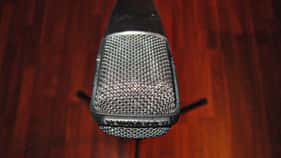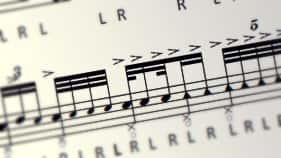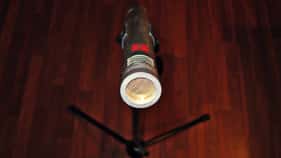
Hi Hat Miking – Find a Sound You’ll Actually Use in the Mix
Red-headed stepchildren, please look away and start at sentence three… Hi hat miking is the red-headed stepchild of drum miking in the studio. Sentence Three: Glad everyone’s back with us. For most people, miking the hi hat is often, at best, an afterthought and, at worst, completely ignored. While it is true that a hi hat mic may be unnecessary, what with modern overhead miking combined with drummers that bash their hats, a crisp distinct channel of just hi hats can also really give the drum set some presence in the mix – especially in verses.
Since we’ve taken the last three weeks to delve into snare drum miking, kick drum miking, and tom miking, I figured we would spend some time this week on the hi hat. I took it upon myself to compare a few different mics on a simple pair of 14” Sabian AAX Stage Hats (non-brilliant finish). Steps were taken to ensure that the different mics remained the same approximate distance from the sound source, pointing at the same angle. Also, all mics were recorded through the same Vintech x81 preamp (with no EQ or compression added) to yield the same apparent volume between mics. Enjoy!
Shure SM57
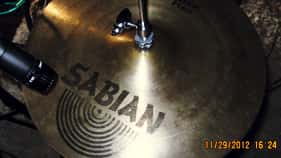 A common microphone laying around any studio, I figured I would start here. I like many other mics much more than a 57 on hats, but I have seen it done so many times that I thought I would offer it here as an aural benchmark, since most of us are familiar enough with the sonic signature of a 57.
A common microphone laying around any studio, I figured I would start here. I like many other mics much more than a 57 on hats, but I have seen it done so many times that I thought I would offer it here as an aural benchmark, since most of us are familiar enough with the sonic signature of a 57.
Shure SM7b
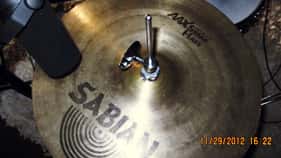 While I am normally a fan of a small diaphragm condenser on the hats, this larger dynamic mic has some surprising sonic characteristics that I keep come back to. It’s not as “chinky” in the mid range as the 57. It still could use a lot of lows rolled off, but it has a nice focus without being pointed. Also, there is no exaggerated high end.
While I am normally a fan of a small diaphragm condenser on the hats, this larger dynamic mic has some surprising sonic characteristics that I keep come back to. It’s not as “chinky” in the mid range as the 57. It still could use a lot of lows rolled off, but it has a nice focus without being pointed. Also, there is no exaggerated high end.
sE2
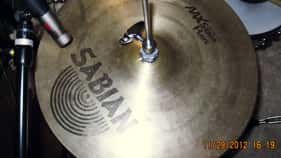 As referenced in the entry about snare drum miking, this is an early edition microphone offered by under-sung company sE. While the company now offers probably improved versions of this mic, I find the sE2 a pleasing choice on certain hats. It features a huge high end boost that can really make dull hats sizzle. Conversely, it can also make bright hats squeal.
As referenced in the entry about snare drum miking, this is an early edition microphone offered by under-sung company sE. While the company now offers probably improved versions of this mic, I find the sE2 a pleasing choice on certain hats. It features a huge high end boost that can really make dull hats sizzle. Conversely, it can also make bright hats squeal.
Neumann KM184
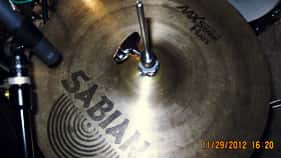 If you want a small diaphragm and a little grit without a lot of high end, this is your mic. It’s dark nature can tame an overly bright pair of hats. The grittiness can help make a less focused pair of hats sound more aggressive. I would not use this mic on anything that sounds overly “metal” and “chinky” as the grittiness of the mic would probably worsen this quality in a pair of hats.
If you want a small diaphragm and a little grit without a lot of high end, this is your mic. It’s dark nature can tame an overly bright pair of hats. The grittiness can help make a less focused pair of hats sound more aggressive. I would not use this mic on anything that sounds overly “metal” and “chinky” as the grittiness of the mic would probably worsen this quality in a pair of hats.
Neumann U-87 Ai
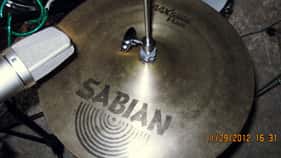 The only large diaphragm condenser I tried in this little experiment, the U-87 Ai is a middle-of-the-road choice. A quick note, for more details on what makes the U-87 Ai different from the legendary U-87, please refer to my entry on snare miking. Here, the lack of low end in the hats and the gradual high end roll off of the mic’s cardioid pattern make the hats sound filtered somehow. It’s not a good sound for most pop and rock recordings, but it would be great for anything moody and vintage.
The only large diaphragm condenser I tried in this little experiment, the U-87 Ai is a middle-of-the-road choice. A quick note, for more details on what makes the U-87 Ai different from the legendary U-87, please refer to my entry on snare miking. Here, the lack of low end in the hats and the gradual high end roll off of the mic’s cardioid pattern make the hats sound filtered somehow. It’s not a good sound for most pop and rock recordings, but it would be great for anything moody and vintage.
If I had access to more mics at the time of this article, I would have liked to provide samples of other hi hat favorites like the AKG 451b, a Microtech Gefell M300, or a vintage Neumann KM84. Still, the point is made that different mics “hear” the hats differently and that, depending on the hats and the occasion, a different mic may yield a better result than just using the same mic for hats on every single session. Who knows, with a good hi hat sound, you may be reaching for the hi hats in the mix more too! Oh, and sorry if I offended any truly red-headed people with stepparents.

